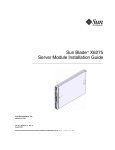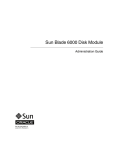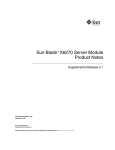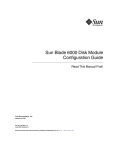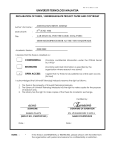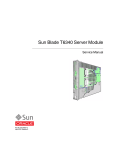Download Sun Blade 6000 Disk Module Product Notes
Transcript
Sun Blade™ 6000 Disk Module Product Notes Sun Microsystems, Inc. www.sun.com Part No. 820-1709-13 October 2009, Revision A Submit comments about this document at: http://www.sun.com/hwdocs/feedback Copyright © 2009 Sun Microsystems, Inc., 4150 Network Circle, Santa Clara, California 95054, U.S.A. All rights reserved. Sun Microsystems, Inc. has intellectual property rights relating to technology embodied in the product that is described in this document. In particular, and without limitation, these intellectual property rights may include one or more of the U.S. patents listed at http://www.sun.com/patents and one or more additional patents or pending patent applications in the U.S. and in other countries. Unpublished - rights reserved under the Copyright Laws of the United States. This distribution may include materials developed by third parties. Sun, Sun Microsystems, the Sun logo, Netra, Sun Ray, Sun Blade 6000 Disk Module and Sun Blade are trademarks or registered trademarks of Sun Microsystems, Inc. or its subsidiaries in the U.S. and other countries. All SPARC trademarks are used under license and are trademarks or registered trademarks of SPARC International, Inc. in the U.S. and other countries. Products bearing SPARC trademarks are based upon architecture developed by Sun Microsystems, Inc. Use of any spare or replacement CPUs is limited to repair or one-for-one replacement of CPUs in products exported in compliance with U.S. export laws. Use of CPUs as product upgrades unless authorized by the U.S. Government is strictly prohibited. DOCUMENTATION IS PROVIDED "AS IS" AND ALL EXPRESS OR IMPLIED CONDITIONS, REPRESENTATIONS AND WARRANTIES, INCLUDING ANY IMPLIED WARRANTY OF MERCHANTABILITY, FITNESS FOR A PARTICULAR PURPOSE OR NON-INFRINGEMENT, ARE DISCLAIMED, EXCEPT TO THE EXTENT THAT SUCH DISCLAIMERS ARE HELD TO BE LEGALLY INVALID. Copyright © 2009 Sun Microsystems, Inc., 4150 Network Circle, Santa Clara, California 95054, Etats-Unis. Tous droits réservés. Sun Microsystems, Inc. détient les droits de propriété intellectuelle relatifs à la technologie incorporée dans le produit qui est décrit dans ce document. En particulier, et ce sans limitation, ces droits de propriété intellectuelle peuvent inclure un ou plusieurs des brevets américains listés à l'adresse suivante: http://www.sun.com/patents et un ou plusieurs brevets supplémentaires ou les applications de brevet en attente aux États - Unis et dans les autres pays. Les droits non publiés sont soumis à la legislation des États-Unis sur le droit d'auteur. Cette distributions peut inclure des éléments développés par des des tiers. Sun, Sun Microsystems, le logo Sun, Netra, Sun Ray, Sun Blade 6000 Disk Module et Sun Blade sont des marques de fabrique ou des marques déposées de Sun Microsystems, Inc. ou ses filiales aux États-Unis et dans d'autres pays. Toutes les marques SPARC sont sujet à licence et sont des marques de fabrique ou des marques déposées de SPARC International, Inc. aux ÉtatsUnis et dans d'autres pays. Les produits supportant les marques SPARC sont basés sur une architecture développée par Sun Microsystems, Inc. L'utilisation de pièces détachées ou d'unités centrales de remplacement est limitée aux réparations ou à léchange standard d'unités centrales pour les produits exportés, conformément à la législation américaine en matière d'exportation. Sauf autorisation par les autorités des ÉtatsUnis, l'utilisation d'unités centrales pour procéder à des mises à jour de produits est rigoureusement interdites. LA DOCUMENTATION EST FOURNIE "EN L'ÉTAT" ET TOUTES AUTRES CONDITIONS, DECLARATIONS ET GARANTIES EXPRESSES OU TACITES SONT FORMELLEMENT EXCLUES, DANS LA MESURE AUTORISEE PAR LA LOI APPLICABLE, Y COMPRIS NOTAMMENT TOUTE GARANTIE IMPLICITE RELATIVE A LA QUALITE MARCHANDE, A L'APTITUDE A UNE UTILISATION PARTICULIERE OU A L'ABSENCE DE CONTREFAÇON. Please Recycle Contents Preface 1. vii Sun Blade 6000 Disk Module Product Notes Firmware Revision History 2 Obtaining the Latest Firmware Updates 2. Hardware Issues 1 2 3 Disk Drive’s Green LED Does not Stop Blinking After Resync Completes (6717566) 4 Amber Locate LED Does not Show X6220 Server Blade HDDs (6711327) 4 Repeated Warning Messages When Inserting or Powering on a Disk Blade, SASNEM, or Disk (6694909) 5 Yellow Service LED for one Disk Comes on After RAID 1E Volume is Created (6706908) 6 Multiple HDD Resynch LEDs May Blink Simultaneously (6663520) 6 Expander Status Change Event Sent When Disk Blade is Hot-Plugged (6625472) 7 During Array Initialization with Build and Verify, HDDs Did Not Show the Green LED (6805033) 7 On the SP Console, Scrolling Characters Cause Difficulty in Cursor Navigation (6812100) 8 Power State of Blades From CMM Show Incorrect Environment (OFF) (6823893) 9 iii When Multiple Reset Commands are Performed the Sun Blade 6000 Will Fail to Power On (6824045) 9 Controller Kernel Stops Running After Reset (6793466) ▼ To reset the controller: ▼ 3. VMWare 12 To reboot the system after reset: Software Issues 9 12 13 13 Solaris Issues Linux Issues 13 14 Windows Issues 14 VMWare ESX does not recognize SCSI IDs (6790706) Solaris OS Will not Install on 1 TByte RAID 14 15 Delete All Partitions Error With SUSE Linux Installer (6729550) 15 raidctl Operations Can Take More Than One Minute (6723851) format Command Shows “Drive Not Available”(6725695) 16 16 Solaris Patch Required for Miniroot of Network Installers (6634536) 17 Solaris 0 5/08 Cannot be Installed From DVD on Server Blades in Filled Chassis (6735573) 18 mpxio-Capable SAS Disks Cannot be Managed by Solaris raidctl (6523832) raidctl -l Truncates Solaris Volume Names (6729161) 18 19 Cannot Reactivate RAID Volumes on Servers Running the Solaris OS Using raidctl (6695619) 19 raidctl Cannot set Hot-Spare (6692827) 20 raidctl -d Operation Can Delete a Mounted RAID Volume (6750744) mpt Driver Warning Messages During Solaris System Boot up (6634061) 20 21 Sun Blade T6300 and T63200 Server Modules Might Hang at Boot (6662335) scsi_vhci.conf Setting for MPxIO Needs to be Reset (6742736) Solaris mpxio-upgrade Incompatible with ZFS (6707555) iv Sun Blade 6000 Disk Module Product Notes • October 2009 23 22 22 Failure to Complete Partition Request With SAS Disks and Windows Server 2003 23 Removing One NEM Causes Windows Server 2003 to Reboot (6715806) 24 Cannot Create Partition on Both Instances of a Dual-Pathed Disk With Windows Server 2003 (6715806) 24 Contents v vi Sun Blade 6000 Disk Module Product Notes • October 2009 Preface This document intended to bring you late breaking information about the system, as well as workarounds for problems you might encounter when installing, configuring, or operating your Sun Blade 6000 Disk Module. This information is designed for system administrators who are experienced with the installation and configuration of the basic system components and its software. Issues include information that you should know about, such as prerequisites, tips, troubleshooting hints, and change requests. Change requests have tracking numbers shown in parentheses. Related Documentation For a description of the document set for the Sun Blade 6000 Disk Module, see the Where To Find Sun Blade 6000 Disk Module Documentation sheet that is packed with your system and also posted at the product's documentation site at this URL: http://docs.sun.com/app/docs/coll/blade6000dskmod Translated versions of some of these documents are available at the web site described above in French, Simplified Chinese, Traditional Chinese, Korean, and Japanese. English documentation is revised more frequently and might be more upto-date than the translated documentation. vii Typographic Conventions Typeface Meaning Examples AaBbCc123 The names of commands, files, and directories; onscreen computer output Edit your.login file. Use ls -a to list all files. % You have mail. AaBbCc123 What you type, when contrasted with onscreen computer output % su Password: AaBbCc123 Book titles, new words or terms, words to be emphasized. Replace command-line variables with real names or values. Read Chapter 6 in the User’s Guide. These are called class options. You must be superuser to do this. To delete a file, type rm filename. Third-Party Web Sites Sun is not responsible for the availability of third-party web sites mentioned in this document. Sun does not endorse and is not responsible or liable for any content, advertising, products, or other materials that are available on or through such sites or resources. Sun will not be responsible or liable for any actual or alleged damage or loss caused by or in connection with the use of or reliance on any such content, goods, or services that are available on or through such sites or resources. Sun Welcomes Your Comments Sun is interested in improving its documentation and welcomes your comments and suggestions. Send feedback to: http://www.sun.com/hwdocs/feedback Please include the title and part number of your document with your feedback: Sun Blade 6000 Disk Module Product Notes, part number 820-1709-13. viii Sun Blade 6000 Disk Module Product Notes • October 2009 CHAPTER 1 Sun Blade 6000 Disk Module Product Notes This document contains late-breaking information and issues for the Sun Blade 6000 Disk Module. Sections included in this document: ■ “Firmware Revision History” on page 2 ■ “Obtaining the Latest Firmware Updates” on page 2 ■ “Hardware Issues” on page 3 ■ “Software Issues” on page 13 1 Firmware Revision History The firmware release history for the Sun Blade 6000 Disk Module and supported SAS NEMs is listed in the following table. Note – Both the disk module and the SAS NEM firmware need to be at the same revision level. TABLE 1-1 Sun Blade 6000 Disk Module and SAS NEM Firmware Firmware Revision Base Firmware Delivery Platform Supported Hardware Description 5.02.10 (502A) Sun Common Array Manager 6.1.2 • Sun Blade 6000 Disk Module • Sun Blade 6000 Multi-Fabric Network Express Module • Sun Blade 6000 10GbE Multi-Fabric Network Express Module • Sun Blade 6000 Virtualized Multi-Fabric 10GbE Network Express Module Initial release. 5.02.14 (502E) Sun Common Array Manager 6.4.1 • Sun Blade 6000 Disk Module • Sun Blade 6000 Multi-Fabric Network Express Module • Sun Blade 6000 10GbE Multi-Fabric Network Express Module • Sun Blade 6000 Virtualized Multi-Fabric 10GbE Network Express Module Support was added for second source to monitor disk module temperature and voltage. Obtaining the Latest Firmware Updates The latest firmware for the Sun Blade 6000 Disk Module is available using the Sun Common Array Manager (CAM), available on the Sun download web site, at: http://www.sun.com/storagetek/management_software/resource_manag ement/cam/get_it.html 2 Sun Blade 6000 Disk Module Product Notes • October 2009 CHAPTER 2 Hardware Issues This chapter describes hardware issues related to the Sun Blade6000 disk module. The following issues are described: ■ “Disk Drive’s Green LED Does not Stop Blinking After Resync Completes (6717566)” on page 4 ■ “Amber Locate LED Does not Show X6220 Server Blade HDDs (6711327)” on page 4 ■ “Repeated Warning Messages When Inserting or Powering on a Disk Blade, SASNEM, or Disk (6694909)” on page 5 ■ “Yellow Service LED for one Disk Comes on After RAID 1E Volume is Created (6706908)” on page 6 ■ “Multiple HDD Resynch LEDs May Blink Simultaneously (6663520)” on page 6 ■ “Expander Status Change Event Sent When Disk Blade is Hot-Plugged (6625472)” on page 7 ■ “During Array Initialization with Build and Verify, HDDs Did Not Show the Green LED (6805033)” on page 7 ■ “On the SP Console, Scrolling Characters Cause Difficulty in Cursor Navigation (6812100)” on page 8 ■ “Power State of Blades From CMM Show Incorrect Environment (OFF) (6823893)” on page 9 ■ “When Multiple Reset Commands are Performed the Sun Blade 6000 Will Fail to Power On (6824045)” on page 9 ■ “Controller Kernel Stops Running After Reset (6793466)” on page 9 ■ “Controller Kernel Stops Running After Reset (6793466)” on page 9 3 Disk Drive’s Green LED Does not Stop Blinking After Resync Completes (6717566) When a RAID resync is in progress, the disk drive’s green LED blinks in a regular pattern. It should stop blinking and stay lit after the resync completes. However, when a faulty disk in a RAID 1 mirror is replaced (in the same slot) the LED continues to blink in some cases, indicating the resynch is still in progress. Workaround The resync status of a RAID volume can be observed using the MegaRAID Storage Manager (MSM) software in Windows and Linux, raidctl in Solaris, or the LSI BIOS Configuration Utility. These are all documented in the Sun LSI 106x RAID User’s Guide (820-4933). The green LED can be reset to the normal condition (solid green) by power cycling the Sun Blade 6000 Modular System Chassis and then removing and re-inserting the Sun Blade 6000 Disk Module. Amber Locate LED Does not Show X6220 Server Blade HDDs (6711327) In the SAS Topology screen of the LSI BIOS Configuration Utility, there is a mechanism to turn on the disk amber LED of the disks in a RAID volume to locate them. This locate feature is not functional for directly attached disks in host server blade disk bays. Workaround In the SAS Topology screen, you can select Direct Attach Devices to view direct attached disks on host server blades. 4 Sun Blade 6000 Disk Module Product Notes • October 2009 The bay number next to the disk shown as a member of the RAID volume corresponds to the silk-screen number on the host server blade’s bays. In the case above, the disk that is a member of the RAID volume is in the disk bay with silkscreen label 1. Repeated Warning Messages When Inserting or Powering on a Disk Blade, SAS-NEM, or Disk (6694909) The following pair of warning messages may appear repeatedly upon insertion of HDDs and upon powering on Sun Blade 6000 Disk Module or Sun Blade 6000 MultiFabric Network Expansion Module: scsi: WARNING: /pci@7c0/pci@0/pci@2/LSILogic,sas@0 (mpt0): mpt_handle_event_sync: IOCStatus=0x7, IOCLogInfo=0x0 Workaround These warning messages are benign and can be ignored. Chapter 2 Hardware Issues 5 Yellow Service LED for one Disk Comes on After RAID 1E Volume is Created (6706908) After creating a RAID 1E volume, one or more of the member disk drive’s amber service LEDs may turn on, even though there is no HDD fault. Workaround If you create a RAID 1E volume, ignore the amber service LEDs on the disk drives. Instead, view the disk drive’s status using the MegaRAID Storage Manager (MSM) software in Windows and Linux, raidctl in Solaris, or the LSI BIOS Configuration Utility. These are all documented in Sun LSI 106x RAID User’s Guide (820-4933). Multiple HDD Resynch LEDs May Blink Simultaneously (6663520) Only one RAID volume at a time can resynch. When volume B needs to resynch, but volume A is resynching, volume B must wait to resynch until the volume A resynch is completed. If a disk in an LSI RAID volume B fails while another RAID volume (volume A) is resynching, the resynch light on the hot-spare for volume B starts blinking even though volume B has not begun to resynch. Workaround This is expected behavior. One volume is resynching and the other is in queue to resynch. You can view the status of each RAID (A is resynching and B is degraded) using the MegaRAID Storage Manager (MSM) software in Windows and Linux, raidctl in Solaris, or the LSI BIOS Configuration Utility. These are all documented in Sun LSI 106x RAID User’s Guide (820-4933). 6 Sun Blade 6000 Disk Module Product Notes • October 2009 Expander Status Change Event Sent When Disk Blade is Hot-Plugged (6625472) When you change your storage hardware configuration, you may see the following Solaris message: mpt0: unknown event 1b received The message is harmless and may be safely ignored. Workaround Ignore the message. Check for the availability of a patch for this defect. During Array Initialization with Build and Verify, HDDs Did Not Show the Green LED (6805033) When a Sun Blade 6000 Disk Module is connected to a Sun Blade RAID 5 Expansion Module (X4620A) and you build a RAID volume that includes disks in slot 4 and/or slot 6, the LEDs on these disk will not blink during RAID initialization, rebuilding or verification. Workaround Use the Sun RAID Manager interface to confirm that disks four and/or six are part of the RAID volume. Alternatively, use the Sun Blade G2 RAID 0/1 Expansion Module (X4607A). Chapter 2 Hardware Issues 7 On the SP Console, Scrolling Characters Cause Difficulty in Cursor Navigation (6812100) When a Sun Blade 6000 Disk Module is connected to a Sun Blade RAID 5 Expansion Module (X4620A) and you attempt to connect to the BIOS through the SP the screen will be obscured by scrolling "5;00H" characters. [I5;00H FIGURE 2-1 Scrolling Characters in Adaptec BIOS Main Menu Workaround 1. Don’t use the SP. Connect to the host blade directly. 2. Use the Sun Blade G2 RAID 0/1 Expansion Module (X4607A). 8 Sun Blade 6000 Disk Module Product Notes • October 2009 Power State of Blades From CMM Show Incorrect Environment (OFF) (6823893) When power is removed from the Sun Blade 6000 Disk Module, whether by power cycling the blade itself or the entire chassis, the power state shown by the CMM command show /CH/ will show the blade as powered off when it is actually powered on Workaround Run the start /CH/ command from the CMM. When Multiple Reset Commands are Performed the Sun Blade 6000 Will Fail to Power On (6824045) When resetting the Sun Blade 6000 Disk Module though the CMM, the power state shown by the CMM command show /CH/ will show the blade as powered off when it is actually powered on. Workaround Use the start /CH/ and stop /CH/ command from the CMM instead of the reset command. Controller Kernel Stops Running After Reset (6793466) The HBA hangs during system reboot or boot up. Chapter 2 Hardware Issues 9 FIGURE 2-2 Reboot Hang The HBA crashes in the Adaptec BIOS RAID manager. 10 Sun Blade 6000 Disk Module Product Notes • October 2009 FIGURE 2-3 Controller Error Chapter 2 Hardware Issues 11 Workaround ▼ To reset the controller: 1. Shut down the CPU blade by pressing the power button in the front panel. 2. Eject the Sun Blade 6000 away from the chassis backplane. 3. Eject all internal HDDs from the backplane (if any). 4. Power up the CPU blade. 5. Press <Ctrl-A> at the RAID BIOS to enter BIOS CU. Make sure that there is no disk in the system. 6. Press <Esc> to exit RAID BIOS and reboot the system. Repeat Step 5, and continue to step 7 7. Press the CPU blade power button to shut down the system. ▼ To reboot the system after reset: 1. At the power off, insert Vela back to the same slot configuration. 2. Insert all internal hard disk drives back to their own slots (If any) 3. Power up the CPU blade. 12 Sun Blade 6000 Disk Module Product Notes • October 2009 CHAPTER 3 Software Issues This chapter describes software issues related to the Sun Blade 6000 disks module. The following issues are described: VMWare “VMWare ESX does not recognize SCSI IDs (6790706)” on page 14 Solaris Issues ■ “Solaris OS Will not Install on 1 TByte RAID” on page 15 ■ “raidctl Operations Can Take More Than One Minute (6723851)” on page 16 ■ “format Command Shows “Drive Not Available”(6725695)” on page 16 ■ “Solaris Patch Required for Miniroot of Network Installers (6634536)” on page 17 ■ “Solaris 0 5/08 Cannot be Installed From DVD on Server Blades in Filled Chassis (6735573)” on page 18 ■ “mpxio-Capable SAS Disks Cannot be Managed by Solaris raidctl (6523832)” on page 18 ■ “raidctl -l Truncates Solaris Volume Names (6729161)” on page 19 ■ “Cannot Reactivate RAID Volumes on Servers Running the Solaris OS Using raidctl (6695619)” on page 19 ■ “mpt Driver Warning Messages During Solaris System Boot up (6634061)” on page 21 ■ “Sun Blade T6300 and T63200 Server Modules Might Hang at Boot (6662335)” on page 22 ■ “scsi_vhci.conf Setting for MPxIO Needs to be Reset (6742736)” on page 22 ■ “Solaris mpxio-upgrade Incompatible with ZFS (6707555)” on page 23 13 Linux Issues ■ “Delete All Partitions Error With SUSE Linux Installer (6729550)” on page 15 Windows Issues ■ “Failure to Complete Partition Request With SAS Disks and Windows Server 2003” on page 23 ■ “Removing One NEM Causes Windows Server 2003 to Reboot (6715806)” on page 24 ■ “Cannot Create Partition on Both Instances of a Dual-Pathed Disk With Windows Server 2003 (6715806)” on page 24 VMWare ESX does not recognize SCSI IDs (6790706) VMware ESX 3.5 fails to recognize disks with SCSI IDs greater than 61 on the Sun Blade 6000 disk module. You may encounter this in installations with very high disk counts, which can occur when more than four disk blades are installed in a single Sun Blade 6000 chassis. When larger configuration exist in the chassis and multipathing is enabled, some disks may not be available for use to ESX. You may occasionally see the error, but there will be no interruption in service. This problem will be fixed in a future release. Workaround Limit the number of disk blades to four per Sun Blade 6000 chassis. 14 Sun Blade 6000 Disk Module Product Notes • October 2009 Solaris OS Will not Install on 1 TByte RAID The Solaris OS cannot be installed on a RAID array larger than one terabyte. The Solaris installer OS doesn’t support it. Workaround There is no workaround for this issue. Delete All Partitions Error With SUSE Linux Installer (6729550) If you choose to delete all partitions during SUSE Linux installation and you are using a disk blade with two SAS-NEMs and no hardware RAID, you will see a popup window with message "system error code was: -1014". Then, when you click OK, the installation aborts. Note – This problem only occurs when you are using an LSI SAS host bus adapter. If you are using an Adaptec host bus adapter, you must create volumes with the BIOS RAID configuration utility, so that the OS is unaware of the second path. Explanation Under the conditions described, each physical disk is shown to the OS as two logical disks. The SUSE installer is not multi-path aware, so it cannot combine two logical disks into one entity. When you choose to delete all partitions, the installer tries to delete partitions on both logical disks. This operation fails and you get the error message. Workaround There are two possible workarounds: Chapter 3 Software Issues 15 1. Choose only one instance of the disk for partition deletion: Reboot the system and restart the installation process. Do not choose to delete any partition except the boot and root file system. Once the OS is installed and booted up, you can make make modification to partition tables. 2. Use the LSI BIOS configuration utility to create a hardware RAID volume. Then the OS is unaware of the second path. raidctl Operations Can Take More Than One Minute (6723851) On SPARC systems raidctl -l and raidctl -S operations could take more than one minutes per disk. Workaround None at present.Check for the availability of a patch for this problem. format Command Shows “Drive Not Available”(6725695) The Solaris format command shows disks as "drive not available" after RAID volumes are created or deleted using raidctl. Workaround There are wo workarounds: 1. Reboot the system. 2. When the format command results in a driver not available message, use the cfgadm -c command to unconfigure the corresponding disk access point, regardless of whether a volume is created or deleted. 16 Sun Blade 6000 Disk Module Product Notes • October 2009 Solaris Patch Required for Miniroot of Network Installers (6634536) Solaris 10 5/08 cannot be installed on server blades whose paired disk blade contains above a certain number of hard drives. A patch must be added to the miniroot of network install servers for users who maintain network install servers. Workaround This is the procedure for adding patch 138076-02 to the x86 miniroot. The procedure must be done on an x86 system running the latest Solaris 10update, with the latest available packaging/patching utilities installed: 1. cd to your Solaris_10/Tools directory. 2. Run setup_install_server to a local directory: # ./setup_install_server -b /export/home/s10u5_patch 3. Unpack the miniroot: # /boot/solaris/bin/root_archive unpackmedia /export/home/s10u5_patch /export/home/s10u5_patch_mr 4. Install the patch. # patchadd -C /export/home/s10u5_patch_mr <patch directory> 5. Pack up the new miniroot: # /boot/solaris/bin/root_archive packmedia /export/home/s10u5_patch /export/home/s10u5_patch_mr Now on your install server, use setup_install_server and then copy the newly generated x86.miniroot over: 1. cd to your Solaris_10/Tools directory. 2. Run setup_install_server to a local directory: # ./setup_install_server /export/home/s10u5_patch 3. Save the old x86.miniroot file: # cd /export/home/s10u5_patch/boot # cp -p x86.miniroot x86.miniroot.orig Chapter 3 Software Issues 17 4. Copy the new x86.miniroot file from the machine on which you built it, for example: # cp -p /net/<machine_name>/export/home/s10u5_patch/boot/x86.miniroot. Solaris 0 5/08 Cannot be Installed From DVD on Server Blades in Filled Chassis (6735573) Solaris 10 5/08 cannot be installed on X6220 blades in a Sun Blade 6000 chassis that contains above a certain number of hard drives in disk blades. An installation from DVD will fail if the chassis is populated with server/disk pairs. Workaround Remove all blades from the chassis except for a single X6220 server blade or a pair of an X6220 server blade and a disk blade. Then install Solaris 10 5/08. After the installation the system should be booted and patch 138076 applied before repopulating the chassis with other blades. mpxio-Capable SAS Disks Cannot be Managed by Solaris raidctl (6523832) If MPxIO is enabled for the mpt SAS driver, raidctl cannot be used to create and manage RAID volumes. Workaround Create RAID volumes with the raidctl utility before enabling MPxIO. If you need to change or create RAID volumes after MPxIO is enabled, disable MPxIO first, make the changes or create the RAID volumes, and re-enable MPxIO. 18 Sun Blade 6000 Disk Module Product Notes • October 2009 raidctl -l Truncates Solaris Volume Names (6729161) When using raidctl -l with a volume name, the output will truncate the volume name to seven characters if the volume target ID is larger than 100. For example, # raidctl -l c0t102d0 Volume Size Stripe Status Cache RAID ---------------------------------------------------------------c0t102d 136.6G 64K OPTIMAL OFF RAID0 Workaround Ignore the volume name that gets listed in the output when raidctl -l <volume name> is used. You can still use the rest of the information displayed. Cannot Reactivate RAID Volumes on Servers Running the Solaris OS Using raidctl (6695619) When a system motherboard or a daughter card (like REMs) with an LSI host bus adapter is replaced in the field, raidctl does not allow reactivation of the RAID volumes. The RAID volume information is in metadata on the disks, but the state of the volume is changed in inactive after the replacement. The raidctl utility does not allow activation of RAID volumes, so that the volume cannot be reactivated on systems running the Solaris OS. Workaround The workaround for SPARC systems is documented in Appendix A of the Sun Blade 6000 Disk Module Service Manual (part number 820-1703). For x64 systems running the Solaris OS (or Linux or Windows), you can reactivate the array using the LSI or Adaptec BIOS RAID configuration utilities. Chapter 3 Software Issues 19 For systems running Linux or Windows, you can also use the LSI MSM software or the Sun StorageTek RAID Manager software (Adaptec controllers). raidctl Cannot set Hot-Spare (6692827) The Solaris raidctl utility cannot set a disk as a hot-spare. The raidctl -a -g options do not work. Workaround None for SPARC systems. For all OS on x64 servers, you can set hot-spares using the LSI or Adaptec BIOS RAID configuration utilities. For systems running Linux or Windows, you can also use the MSM software or the Sun StorageTek RAID Manager software (Adaptec controllers). raidctl -d Operation Can Delete a Mounted RAID Volume (6750744) The raidctl -d operation does not check for mounted RAID volumes and will delete such a volume even if it is mounted. Workaround There is no workaround. Before deleting a volume using the raidctl -d option, please use the mount command to check to see if there are any mounted partitions on the volume. For example: # raidctl -l | egrep -i volume Controller: 0 Volume:c0t20d0 20 Sun Blade 6000 Disk Module Product Notes • October 2009 To see if any partitions on volume c0t20d0 are mounted, execute this command: # mount | egrep c0t20d0 / on /dev/dsk/c0t20d0s0 read/write/setuid/devices/intr/largefiles/logging/xattr/onerror= panic/dev=800008 on Fri Oct 3 16:16:17 2008 /export/home on /dev/dsk/c0t20d0s7 read/write/setuid/devices/intr/largefiles/logging/xattr/onerror= panic/dev=80000f on Fri Oct 3 16:16:28 2008 This output indicates that the volume does have mounted partitions, one of which is the root (boot) partition, so deleting the volume will lose that data and render the system unbootable. Deleting this volume is inadvisable. mpt Driver Warning Messages During Solaris System Boot up (6634061) After making storage hardware configuration changes, you may see warning messages during Solaris system boot up similar to the following: WARNING: /pci@0/pci@0/pci@2/scsi@0 (mpt0): mpt_get_sas_device_page0 config: IOCStatus=0x8022, IOCLogInfo=0x30030501WARNING: /pci@0/pci@0/pci@2/scsi@0 mpt_get_sas_device_page0 config: IOCStatus=0x8022, IOCLogInfo=0x30030501WARNING: /pci@0/pci@0/pci@2/scsi@0 mpt_get_sas_device_page0 config: IOCStatus=0x8022, IOCLogInfo=0x30030501WARNING: /pci@0/pci@0/pci@2/scsi@0 mpt_get_sas_device_page0 config: IOCStatus=0x8022, IOCLogInfo=0x30030501WARNING: /pci@0/pci@0/pci@2/scsi@0 (mpt0): (mpt0): (mpt0): (mpt0): These messages are harmless and may be safely ignored. Workaround Ignore the messages. To eliminate them from future reboots, run devfsadm -C to remove any outdated device links. Chapter 3 Software Issues 21 Sun Blade T6300 and T63200 Server Modules Might Hang at Boot (6662335) Sun Blade T6300 and T6320 Server Modules can hang at boot when Sun Blade 6000 10GbE Multi-Fabric NEM is used. This occurs infrequently. Workaround Reboot or reset from Open boot until fix for is available. Contact Sun Service Center if three successive reboot cycles does not resolve the issue. scsi_vhci.conf Setting for MPxIO Needs to be Reset (6742736) By default when Solaris is installed, multi-pathed IO (MPxIO) to Vela disks is disabled. When this feature is enabled by the user, the load-balance variable in the file /kernel/drv/scsi_vhci.conf defaults to round-robin. It should be reset to none. Setting load-balance=none will cause only one path to be used for active IO, with the other path used for failover. A serious performance degradation will result if the load-balance variable is left set to round-robin since that would result in IO being attempted on the passive path. 22 Sun Blade 6000 Disk Module Product Notes • October 2009 Solaris mpxio-upgrade Incompatible with ZFS (6707555) When enabling or disabling MPxIO in conjunction with ZFS root, the system will not reboot cleanly because the mpxio-upgrade does not know how to handle ZFS root. Workaround 1. Disable the mpxio-upgrade service. 2. Run /lib/mpxio/stsmboot_util -u 3. Reboot. Failure to Complete Partition Request With SAS Disks and Windows Server 2003 When a Windows Server 2003 (32-bit or 64-bit) OS is installed on a SAS disk in a Server Module disk and there are two Multi-Fabric NEMs in the chassis, each physical disk on a Sun Blade Disk Module will show up as two different disks in Windows. However, only one of these disks can have a physical partition allocation. If you attempt to create another partition on the second disk, Windows Logical Disk Manager will not be able to complete the request. Workarounds 1. Create a partition on only one of the two disks. 2. Create a hardware RAID volume using the SAS host bus adapter’s RAID configuration utility (entered through the server’s BIOS on initial boot-up). The the OS will see only one disk. Chapter 3 Software Issues 23 Removing One NEM Causes Windows Server 2003 to Reboot (6715806) When a Windows Server 2003 (32-bit and 64-bit) OS is installed on a SAS disk in a disk module and there are two Multi-Fabric NEMs in the chassis, there are two paths to the disk where the OS resides. Removing one NEM breaks one path and the OS automatically reboots. Workarounds ■ Install the OS on a disk in the server blade, if the server blade supports direct attached disks. Such disks have only one path to the SAS host bus adapter and thus to the OS. This path does not go through the Multi-Fabric NEM. ■ If you install your OS on a disk in a disk blade, power down any Windows Server 2003 server blades in the system before when removing the NEM. Cannot Create Partition on Both Instances of a Dual-Pathed Disk With Windows Server 2003 (6715806) When a Windows Server 2003 (32-bit or 64-bit) OS is installed and there are two Multi-Fabric NEMs in the chassis, each physical disk on a Sun Blade Disk Module will show up as two different disks in Windows. However, only one of these disks can have a physical partition allocation. If the user attempts to create another partition with the second disk, Windows Logical Disk Manager will not be able to complete the request. Workarounds 24 ■ Create a partition on only one of the “two” disks. ■ Create a hardware RAID volume using the SAS host bus adapter’s RAID configuration utility (entered through the server’s BIOS on initial boot-up). Sun Blade 6000 Disk Module Product Notes • October 2009
































